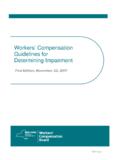Transcription of Energy Use and Loss and Emissions Petroleum
1 Manufacturing Energy Use and Greenhouse Gas Emissions Analysis 69 Petroleum REFINING SECTOR (NAICS 324110) Overview of the Petroleum Refining Manufacturing Sector Petroleum refining is a complex industry that generates a diverse slate of fuel products and petrochemicals, from gasoline to asphalt. Refining requires a range of processing steps, including distillation, cracking, reforming, and treating. Most of these processes are highly reliant on process heating and steam Energy . Petroleum refineries are an essential part of the economy. Crude oil and refined Petroleum products have become some of the most highly scrutinized trading commodities in the world. The Energy profile of this manufacturing sector is unique compared to other manufacturing sectors in that feedstock and many of the manufactured products are Energy commodities that are often measured in terms of Energy content, separate from the Energy content of purchased fuels and electricity.
2 Most other manufacturing sectors are highly dependent on refined Petroleum products. Energy Use Profile for the Petroleum Refining Sector The Petroleum refining sector is the largest consumer of fuel in manufacturing, when considering the inclusion of feedstocks or without feedstocks. Close to 90% of onsite fuel use in refining is applied toward process heating, 65% directly and an additional 23% for the generation of steam used in process The Petroleum refining sector has the largest process heating Energy demand of all manufacturing sectors, and correspondingly is also the largest generator of onsite GHG combustion Emissions . A snapshot of how the Petroleum refining sector ranks in terms of Energy use and losses within manufacturing is shown in Table Energy losses are shown in red font.
3 All values are based on the most currently available complete set of manufacturing Energy use statistics, representing annual Energy use and loss values for calendar year 2006. The Petroleum refining sector ranks first in onsite Energy use. Since Petroleum refineries use proportionally less electricity than fuel compared to other manufacturing sectors the sector falls to third in rank for total primary Energy use (accounting for offsite electricity generation and transmission losses). In addition, a large portion of electricity is produced onsite (34% of process and nonprocess electricity demand is produced onsite, compared to 15% for all of manufacturing). The sector ranks first in process applied Energy due to the high process heating fuel demand. Table Snapshot of the Petroleum refining sector.
4 Energy use and rank within manufacturing Category Rank Energy (TBtu) Total primary Energy 3 3,546 Offsite losses 8 315 Onsite Energy 1 3,231 Onsite losses 3 1,052 Steam generation and distribution 3 350 Electricity generation 3 40 Process Energy 3 641 Nonprocess Energy 11 20 Feedstock Energy 1 3,399 Total primary and feedstock Energy * 1 6,944 GHG combustion Emissions MMT CO2e Total 2 244 Onsite 1 210 *When total primary Energy and feedstock Energy are summed, the Energy value of byproduct fuels derived from feedstock Energy sources is excluded to avoid double counting of feedstock Energy 12 The end use of steam is not provided in the EIA MECS source data. For the Petroleum refining sector, it is assumed that 66% of steam production is used in for process heating, 16% for machine driven processes, 2% for process cooling and refrigeration, 10% for other process uses, 4% for facility HVAC, and 2% other nonprocess applications.
5 More detail is available in Appendix D. 70 Manufacturing Energy Use and Greenhouse Gas Emissions Analysis Although it is outside the scope of the footprint analysis, it is worth noting that a significant amount of Energy is consumed as non-fuel feedstock in the production of refined Petroleum products. As reported in the MECS data, and shown in Fig. , the total feedstock Energy consumed in this sector is 3,399 TBtu, which equates to about half of all reported feedstock Energy consumed in all of manufacturing. When feedstock and fuel Energy are combined, total primary fuel and feedstock Energy used in Petroleum refining is about quads. This is more than any other manufacturing sector and approximately 25% of all fuel and feedstock Energy use in manufacturing. Fig. Feedstock Energy use in the Petroleum refining sector There is limited clarity regarding the composition of other fuels used as feedstock Energy in this sector.
6 In the MECS source data, feedstock Energy for Petroleum refining falls into the category of Other Fuel and is defined as follows:13 The total feedstock Energy consumed in Petroleum refining is significantly greater than quads when accounting for feedstock Energy that is converted to Energy products, such as the conversion of crude oil into gasoline. Many of these Energy products are subsequently used as purchased fuels. The focus of the Energy use and loss analysis that follows excludes all feedstock Energy use. 13 This definition can be found on the following website, , in Table , under the definition of Other Fuel. 'Other' includes Energy that respondents indicated was used as feedstock/raw material inputs. For the Petroleum refining sector only (NAICS 324110), the feedstocks and raw material inputs for the production of nonenergy products ( , asphalt, waxes, lubricants, and solvents) and feedstock consumption at adjoining petrochemical plants are included in the 'Other' column, regardless of type of Energy .
7 Those inputs and feedstocks that were converted to other Energy products ( , crude oil converted to residual and distillate fuel oils) are excluded. Manufacturing Energy Use and Greenhouse Gas Emissions Analysis 71 Energy and carbon footprint The Manufacturing Energy and Carbon Footprint for the Petroleum refining sector is shown in Fig. and Fig. The footprints serve as the basis for characterizing the offsite and onsite flow of Energy , as well as carbon Emissions , from generation through end use in the sector. Fig. Total Energy and carbon footprint for the Petroleum refining sector 72 Manufacturing Energy Use and Greenhouse Gas Emissions Analysis Fig. Onsite Energy and carbon footprint for the Petroleum refining sector Primary Energy Primary Energy includes fuels, electricity, and steam from both onsite and offsite sources, including generation and distribution losses.
8 In essence, primary Energy provides the full picture of total fuel Energy use from all sources from generation to end use. In 2006, the Petroleum refining sector used 3,546 TBtu of primary Energy . There are three main primary offsite Energy generation areas: steam generation, electricity generation, and direct fuel use. In Fig. , it can be seen that the majority of primary Energy use, 58%, is attributed to direct fuel use. Steam generation is the next largest contributor at 28%, with the remaining 14% comprising electricity generation. Consistent with the footprints, blue represents steam Energy , red represents electric Energy , and yellow represents fuel Energy . Manufacturing Energy Use and Greenhouse Gas Emissions Analysis 73 Fig. Primary Energy by Energy type in the Petroleum refining sector Approximately 20% of the primary Energy used in Petroleum refining manufacturing is lost during utility production (encompassing generation, transmission, and distribution), with 9% associated with electricity production and the remaining 11% with steam production.
9 The percentage of utility production loss is lower for Petroleum refining than other sectors given that the majority of primary Energy is direct fuel use where there is no significant generation losses accounted for. In contrast, over half of the primary Energy for electricity generation is lost to generation and transmission losses; this is attributed mostly to offsite losses where the efficiency of electricity supplied from the grid is estimated to be only The primary Energy use values in Fig. are not directly apparent on the Energy and carbon footprints as the footprint is presented in terms of offsite and onsite Energy end use, not primary Energy end use. The primary Energy values in Fig. are obtained from the footprint model and can be derived from the footprints by summing offsite and onsite generation and loss values.
10 The primary direct fuel use, 2,069 TBtu, is the amount of fuel directed to process and nonprocess end uses after the subtraction of fuel for onsite generation. Almost half of this primary fuel use is waste gas, or what is referred to in refining as refinery fuel gas, consisting primarily of hydrogen, methane, and other light-end gases. 74 Manufacturing Energy Use and Greenhouse Gas Emissions Analysis Onsite Energy About quads, or 91% of primary Energy , were consumed onsite by the Petroleum refining sector in 2006. This onsite Energy enters the plant boundary in the form of three offsite Energy types: fuel, steam, and electricity. As shown in Fig. this Energy is primarily fuel, with only a small amount of offsite Energy supply in the form of steam and electricity (3% and 4% respectively).














